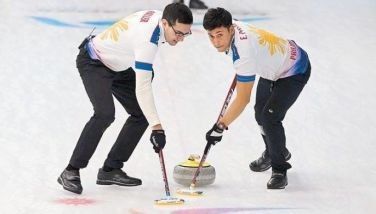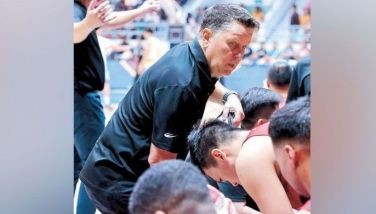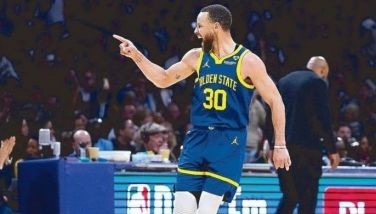Losing hair over premature balding

June 14, 2004 | 12:00am
University of the Philippines researchers came up with a disturbing finding some years back about Filipino male spending. They said the average head-of-family spends a tenth of his salary on liquor within a day of drawing it. Booze drowns out the worry whether he’ll still have a job the next day. I think they’re wrong. From my own research, men spend more money on and more time worrying about the gravest matter of all: premature balding.
Baldness is the Filipino male’s worst fear. I speak not only from experience, but also from confessions of buddies who use close to half their incomes to combat hair loss. If those UP researchers will go back to the drawing board, I’m sure they’ll discover that the average head-of-family would rather see his kids go hungry than see himself in the mirror hairless.
It’s cultural. No Filipino takes a bald man seriously. Notice that guy in Malacañang who sometimes speaks for the President? Palace reporters swear they never believe a word he says. By contrast, look at campaign spokesmen Mike Defensor and Francis Escudero, who brought their principals to the top of the presidential race. Surely they were chosen for what’s in their head as much as what’s on it.
I guess it’s because we grew up watching bald comedians like Pugo and Tugo and their successors. They were just for laughs, never for serious stuff. For unexplained reasons, boys would tap each other on the pate and shout "Pendong" whenever a baldie walks by. Somehow it stuck in our mind. All baldies are comics. But we wouldn’t want to be treated as such, not if we’re chairmen of the board, or senators of the realm, or columnists.
And so, we make a lot of effort to fight the malady. The war starts early in life. For, statistics show that five percent of us begin to have more face to wash than hair to comb at age 20. By 40, half of us show signs of battle fatigue. More so by 60 when, at the peaks of serious careers, 87 percent of us have almost lost the fight.
No one surrenders, though. For, the books offer lots of tricks to baffle the enemy. Some compensate by growing a beard, to draw attention away from the pate onto the chin. That guy in Malacañang has one, see? Others "borrow" hair from the sides, combing it up and over the bald top. It’s called the shaggy look, short for sa gilid humiram. Others resort to the hat trick, wearing baseball caps or bike helmets even to black-tie affairs, to exude sporty machismo and, of course, hide that embarrassing nakedness.
Fortunately, medical science is on our side. Doctors have coined a natty term for our condition: male pattern hair loss, or MPHL. If that isn’t hifalutin enough, there’s an even grander tongue-twister: androgenetic alopecia, or AGA. Watching Aga Muhlach’s TV ads closer these days, I notice that he too is beginning to show signs of our debilitation. You see, with AGA, there’s comfort in numbers. Or maybe not – once you learn that male chimpanzees too experience it. At any rate, the pharmaceutical firm Merck Sharp and Dohme recently launched a support group called ProHAIR (Proper Hair Care For Men), complete with a hotline for distraught AGA sufferers: (02) 878-6338. It also has a fax for those who want to share novels about failed romances due to hair loss: (02) 813-1172.
Doctors say it’s hereditary, like most cancers. A man can inherit the trait from his mother’s or father’s side. Too bad we can’t choose our relatives. My dad succumbed to cancer, which means I’m predisposed – to AGA, I mean. He had it too, but he covered himself with a neat toupee even in sick bed.
There are other causes: stress, hypothyroidism, medications for chemotherapy, depression and hypertension, and blood thinners. Me, I started losing hair over premature balding when I turned 40. It came, ironically, the morning after I read in a book on trivia that hair continues to grow even after a man dies.
Scientists the world over have developed cures. I remember from my youth a Japanese product called Kaminomoto, which my dad tried. It smelled nice. I used to daub myself with it when going to teen parties, to make the girls know I’m a real man. There are many new anti-AGA preparations today. Ricky Reyes sells a black shampoo that promises to regrow. There’s also a product called just that: Regroe. And there’s Foltene. A friend who used to be with a presidential cabinet recommended to me a thick shampoo originally formulated to give horse mane a good shine. It’s the latest male craze in America. The cabinet friend whispered that I use the horse shampoo "down there" as well, with the hope that "it" may grow longer. I haven’t tried, fearful that I might grow a tail. There’s also Propecia to combat alopecia. The makers trace AGA to hyperactivity beneath the scalp of dihydrotestosterone (DHT), a hormone that shortens a man’s hair-growing phase. The product inhibits DHT and thus restores the user to the growth phase.
There are other ways. Newspapers carry ads daily of clinics that use various techniques, from scalp massages to hair transplants from the nape to the pate. They’re expensive, but also status symbols. Patients invariably drive around in Beamers or Benzes.
And there are sleek toupees. One brand caught on so well that wigs generically came to be known as Felucca. My Uncle Pepe, a one-time comedian but later a serious composer, refused to wear one, at first. He preferred to spread on his shiny pate a ghastly concoction taught by a hermit in Mt. Banahaw. It involved catching the bulgiest houseflies and grinding them on mortar while carefully adding just the right amount of virgin coconut oil. He was such a gross comic. He’d regale us with details of his painstaking preparations – over family dinners.
Did the concoction work? I suppose so. Uncle Pepe now has a full head of hair. Sometimes it’s jet black. Other times, it’s graying on the sides. Auntie Glo, his wife, keeps all the Felucca receipts.
E-mail: jariusbondoc@workmail.com
Baldness is the Filipino male’s worst fear. I speak not only from experience, but also from confessions of buddies who use close to half their incomes to combat hair loss. If those UP researchers will go back to the drawing board, I’m sure they’ll discover that the average head-of-family would rather see his kids go hungry than see himself in the mirror hairless.
It’s cultural. No Filipino takes a bald man seriously. Notice that guy in Malacañang who sometimes speaks for the President? Palace reporters swear they never believe a word he says. By contrast, look at campaign spokesmen Mike Defensor and Francis Escudero, who brought their principals to the top of the presidential race. Surely they were chosen for what’s in their head as much as what’s on it.
I guess it’s because we grew up watching bald comedians like Pugo and Tugo and their successors. They were just for laughs, never for serious stuff. For unexplained reasons, boys would tap each other on the pate and shout "Pendong" whenever a baldie walks by. Somehow it stuck in our mind. All baldies are comics. But we wouldn’t want to be treated as such, not if we’re chairmen of the board, or senators of the realm, or columnists.
And so, we make a lot of effort to fight the malady. The war starts early in life. For, statistics show that five percent of us begin to have more face to wash than hair to comb at age 20. By 40, half of us show signs of battle fatigue. More so by 60 when, at the peaks of serious careers, 87 percent of us have almost lost the fight.
No one surrenders, though. For, the books offer lots of tricks to baffle the enemy. Some compensate by growing a beard, to draw attention away from the pate onto the chin. That guy in Malacañang has one, see? Others "borrow" hair from the sides, combing it up and over the bald top. It’s called the shaggy look, short for sa gilid humiram. Others resort to the hat trick, wearing baseball caps or bike helmets even to black-tie affairs, to exude sporty machismo and, of course, hide that embarrassing nakedness.
Fortunately, medical science is on our side. Doctors have coined a natty term for our condition: male pattern hair loss, or MPHL. If that isn’t hifalutin enough, there’s an even grander tongue-twister: androgenetic alopecia, or AGA. Watching Aga Muhlach’s TV ads closer these days, I notice that he too is beginning to show signs of our debilitation. You see, with AGA, there’s comfort in numbers. Or maybe not – once you learn that male chimpanzees too experience it. At any rate, the pharmaceutical firm Merck Sharp and Dohme recently launched a support group called ProHAIR (Proper Hair Care For Men), complete with a hotline for distraught AGA sufferers: (02) 878-6338. It also has a fax for those who want to share novels about failed romances due to hair loss: (02) 813-1172.
Doctors say it’s hereditary, like most cancers. A man can inherit the trait from his mother’s or father’s side. Too bad we can’t choose our relatives. My dad succumbed to cancer, which means I’m predisposed – to AGA, I mean. He had it too, but he covered himself with a neat toupee even in sick bed.
There are other causes: stress, hypothyroidism, medications for chemotherapy, depression and hypertension, and blood thinners. Me, I started losing hair over premature balding when I turned 40. It came, ironically, the morning after I read in a book on trivia that hair continues to grow even after a man dies.
Scientists the world over have developed cures. I remember from my youth a Japanese product called Kaminomoto, which my dad tried. It smelled nice. I used to daub myself with it when going to teen parties, to make the girls know I’m a real man. There are many new anti-AGA preparations today. Ricky Reyes sells a black shampoo that promises to regrow. There’s also a product called just that: Regroe. And there’s Foltene. A friend who used to be with a presidential cabinet recommended to me a thick shampoo originally formulated to give horse mane a good shine. It’s the latest male craze in America. The cabinet friend whispered that I use the horse shampoo "down there" as well, with the hope that "it" may grow longer. I haven’t tried, fearful that I might grow a tail. There’s also Propecia to combat alopecia. The makers trace AGA to hyperactivity beneath the scalp of dihydrotestosterone (DHT), a hormone that shortens a man’s hair-growing phase. The product inhibits DHT and thus restores the user to the growth phase.
There are other ways. Newspapers carry ads daily of clinics that use various techniques, from scalp massages to hair transplants from the nape to the pate. They’re expensive, but also status symbols. Patients invariably drive around in Beamers or Benzes.
And there are sleek toupees. One brand caught on so well that wigs generically came to be known as Felucca. My Uncle Pepe, a one-time comedian but later a serious composer, refused to wear one, at first. He preferred to spread on his shiny pate a ghastly concoction taught by a hermit in Mt. Banahaw. It involved catching the bulgiest houseflies and grinding them on mortar while carefully adding just the right amount of virgin coconut oil. He was such a gross comic. He’d regale us with details of his painstaking preparations – over family dinners.
Did the concoction work? I suppose so. Uncle Pepe now has a full head of hair. Sometimes it’s jet black. Other times, it’s graying on the sides. Auntie Glo, his wife, keeps all the Felucca receipts.
BrandSpace Articles
<
>
- Latest
- Trending
Trending
Latest
Latest
Recommended



























